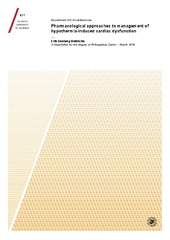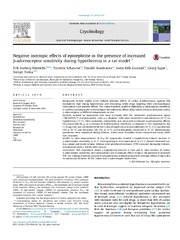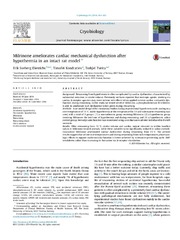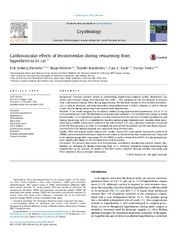| dc.contributor.advisor | Torkjel, Tveita | |
| dc.contributor.author | Dietrichs, Erik Sveberg | |
| dc.date.accessioned | 2018-02-27T09:07:48Z | |
| dc.date.available | 2018-02-27T09:07:48Z | |
| dc.date.issued | 2015-03-20 | |
| dc.description.abstract | We performed randomized, controlled experimental studies in an intact rat model and in isolated rat cardiomyocytes with the following aims:
Paper I:
To investigate the effects of epinephrine during hypothermia and after rewarming and determine hypothermia-induced effects on in vivo and in vitro cardiac β-receptor sensitivity.
Paper II:
To describe hemodynamic responses to the phosphodiesterase 3 (PDE3) inhibitor milrinone when compared to saline infusion during rewarming from deep, stable hypothermia (15°C).
Paper III:
To describe hemodynamic response and phosphorylation of cardiac troponin I (cTnI) during rewarming from deep, stable hypothermia with use of the calcium sensitizer and PDE3 inhibitor levosimendan, compared to animals given placebo.
Main results and conclusions:
β-receptor sensitivity is increased in hypothermia (15°C) compared to normothermia (37°C) (paper I), but administering epinephrine at 15°C had adverse effects, expressed with increased afterload and negative inotropy. Cardiac dysfunction during rewarming from stable hypothermia is however ameliorated by PDE3 inhibition alone (paper I) and combined with calcium sensitizing (paper III). PDE3 inhibition through levosimendan possesses the ability to increase cTnI phosphorylation after rewarming from stable hypothermia (paper III). Treatment of hypothermia-induced cardiac dysfunction is therefore better achieved through intracellular strategies like PDE3 inhibition and calcium sensitizing than β-receptor stimulation. | en_US |
| dc.description.doctoraltype | ph.d. | en_US |
| dc.description.popularabstract | Under oppvarming av nedkjølte pasienter er hjertesvikt en livstruende komplikasjon. I dette doktorgradsarbeidet har vi gitt medikamenter for å behandle slik hjertesvikt. I det første arbeidet har vi vist at den positive effekten av adrenalin forsvinner under hypotermi og at dette skyldes sammentrekning av perifere kar, som øker motstanden mot hjertets evne til å pumpe blod ut i kretsløpet. I de to påfølgende studiene ville vi derfor undersøke effekten av medikamenter som har andre virkningsmekanismer og fant at medikamentene milrinone og levosimendan økte hjertets pumpekraft, uten å øke den perifere motstanden i kretsløpet.
Dette arbeidet har skapt ny innsikt i hvordan medikamenter fungerer under hypotermi. På sikt kan dette bidra til å bedre behandlingen av nedkjølte pasienter og dermed øke overlevelsen i denne pasientgruppa. | en_US |
| dc.description.sponsorship | Stiftelsen Norsk Luftambulanse | en_US |
| dc.identifier.uri | https://hdl.handle.net/10037/12217 | |
| dc.language.iso | eng | en_US |
| dc.publisher | UiT The Arctic University of Norway | en_US |
| dc.publisher | UiT Norges arktiske universitet | en_US |
| dc.rights.accessRights | openAccess | en_US |
| dc.rights.holder | Copyright 2015 The Author(s) | |
| dc.rights.uri | https://creativecommons.org/licenses/by-nc-sa/3.0 | en_US |
| dc.rights | Attribution-NonCommercial-ShareAlike 3.0 Unported (CC BY-NC-SA 3.0) | en_US |
| dc.subject | VDP::Medisinske Fag: 700::Klinisk medisinske fag: 750::Anestesiologi: 765 | en_US |
| dc.subject | VDP::Medical disciplines: 700::Clinical medical disciplines: 750::Anesthesiology: 765 | en_US |
| dc.subject | VDP::Medisinske Fag: 700::Klinisk medisinske fag: 750::Kardiologi: 771 | en_US |
| dc.subject | VDP::Medical disciplines: 700::Clinical medical disciplines: 750::Cardiology: 771 | en_US |
| dc.subject | VDP::Medisinske Fag: 700::Basale medisinske, odontologiske og veterinærmedisinske fag: 710::Klinisk farmakologi: 739 | en_US |
| dc.subject | VDP::Medical disciplines: 700::Basic medical, dental and veterinary science disciplines: 710::Clinical pharmacology: 739 | en_US |
| dc.title | Pharmacological Approaches To Management Of Hypothermia-Induced Cardiac Dysfunction | en_US |
| dc.type | Doctoral thesis | en_US |
| dc.type | Doktorgradsavhandling | en_US |


 English
English norsk
norsk






